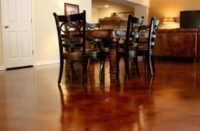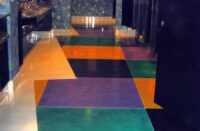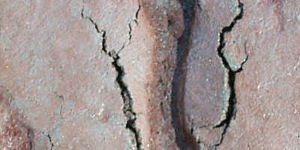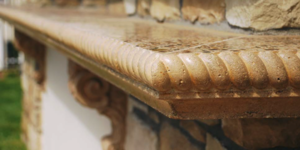 Accelerators are one of the most popular kinds of chemical admixtures. Like water reducers, retarders and plasticizers, when added to a concrete batch either immediately before or during mixing.
Accelerators are one of the most popular kinds of chemical admixtures. Like water reducers, retarders and plasticizers, when added to a concrete batch either immediately before or during mixing.
To kick the set time of a batch of concrete into high gear, hit the accelerator.
Like water reducers, retarders and plasticizers, accelerators are one of the most popular kinds of chemical admixtures, added to a concrete batch either immediately before or during mixing. Accelerators make concrete set faster, also known as increasing the rate of hydration. At the same time, they promote strength development so it happens earlier in the set time of a slab.
 If a contractor is using an accelerator, the odds are good that the weather is wintry. Accelerators counteract the influence of cold weather, which slows down the curing and setting process.
If a contractor is using an accelerator, the odds are good that the weather is wintry. Accelerators counteract the influence of cold weather, which slows down the curing and setting process.
But accelerators aren’t just for cold weather. A contractor can use one anytime a curing process needs a kick. The admixture may allow a concrete worker to remove forms earlier, get onto a concrete surface earlier for finishing, and sometimes even put loads on it earlier, such as when diverting foot traffic to do patching.
“Decorative guys will use accelerators in summer. It helps control the process when stamping,” says Terry Collins, concrete construction engineer with the Portland Cement Association.
If an accelerator is added to concrete on one half of a pour, a contractor can start stamping on that side, work his way to the other side, and enjoy a relatively consistent level of workability throughout. Decorative contractors have been using retarding admixtures for several years to achieve this effect, says Gabriel Ojeda, president of concrete admixture manufacturer Fritz-Pak Corp., and accelerators can pull off more or less the same trick.
Because accelerators cut set time, they can reduce labor costs, Ojeda says. They can also hasten the time an indoor remodel job, such as a cast-in-place countertop, takes to set, Ojeda says. “You don’t want people to have to wait seven, 10, 15 days without being able to use their kitchen,” he says.
And while they do cost a little extra, accelerators may still be a better bargain than, say, natural gas. “If you don’t accelerate, and you have a short set time, the other option is heat,” Ojeda says. “Heat is now more expensive because of energy consumption. It may be cheaper to use accelerators than to heat a building.”
Calcium chloride pros and cons
A number of chemicals qualify as accelerators, but the most common is calcium chloride. It’s cheap, plentiful, and readily available from huge chemical companies.
However, while calcium chloride may be the cheap favorite for concrete in general, it is not necessarily the best option for decorative concrete.
Calcium chloride slightly increases workability and reduces the water required to achieve a given slump in a mix, according to a report from the Federal Highway Administration. It reduces initial and final setting times, and it improves compressive and flexural strengths of concrete at early ages.
Guidelines published by the Portland Cement Association list colored concrete among the jobs in which calcium chloride “should be used with caution.” The guidelines also state that slabs intended to receive dry-shake metallic finishes should not take calcium chloride or admixtures that contain soluble chlorides, and neither should most slabs poured in hot weather.
Decorative concrete contractors are going to be discouraged from using calcium chloride, says Collins of the PCA. It can inhibit the ability of acid stain to react with cement in the concrete. And it increases the potential for efflorescence. These aren’t significant problems on generic concrete slabs, but on decorative jobs, they can be distressing.
Most people see a little bit of white powder on the sidewalk, they sweep it off and forget about it,” Collins says. “But they see a little bit of white powder on decorative concrete and they tend to believe the world is ending, there’s something wrong with it.”
Excessive amounts of calcium chloride may cause rapid stiffening and shrinkage while drying, creating cracks in the cured surface. Calcium chloride may promote corrosion in steel reinforcements and increase the potential for scaling.
Perhaps most troubling for decorative contractors, calcium chloride may darken their slab. The chemical is hydroscopic. Just as table salt gets hard absorbing water from the air, calcium chloride literally liquefies. “If you put a pile of it on a table and come back in the morning, it will be all water,” Ojeda says.
That’s essentially how calcium chloride can make concrete darker, Ojeda says. Say a colored slab with calcium chloride is half in the shade, half in the sun. Rain or moisture will linger longer on the shady portion, get sucked into the slab by the calcium chloride, and make that part darker. The change won’t be significant, he acknowledges, but “it’s still enough to make a difference in color between the shaded area and sunny area.”
Calcium chloride’s potential to oxidize might also change the tint of colors and pigments that are based on iron oxide, he says.
Contractors can take steps to minimize cracking caused by calcium chloride’s shrinkage, says Tim Reason, president of Chargar Corp., a manufacturer of concrete and masonry products. “You may try to keep the surface wet and damp during the curing process. That might help a little bit.”
Reason also downplays the concern that calcium chloride may promote corrosion of reinforcing steel, noting that, even if it occurred, the corrosion would take a long time to become a real problem. “The corrosion issue is something they’ve been saying for a hundred years, but I don’t know if they’ve definitely proved it,” he says. “It may. But how long is it going to take? It’s not like it’s going to deteriorate in a year or so.”
Alternatives
In any case, contractors who want to accelerate their concrete aren’t forced to use calcium chloride. There are alternatives. “Although calcium chloride is an effective and economical accelerator, its corrosion-related problem limited its use and forced engineers to look for other options, mainly nonchloride accelerating admixtures,” states the FHA report.
Sodium thiocyanate, triethanolamine, and calcium formate, nitrate and nitrite are among the “nonchlorides” that have been successfully used to accelerate concrete set times.
There are four of the most common:
- Calcium formate: Mostly used in powder form for materials such as dry bricking and stuccos. It may require slightly more material per pound than calcium chloride to achieve the same effect, and it can react with certain cement compositions to alter compressive strength development. It cannot be used in a highly concentrated solution.
- Triethanolamine: Described in the FHA report as an “oily, water-soluble liquid with a fishy odor.” It’s very dose sensitive, and if too much is used, it acts as a retardant. It’s also very toxic.
- Calcium nitrite: More toxic than calcium nitrates (although toxicity isn’t much of an issue once something is embedded in a concrete mix). It prevents corrosion.
- Calcium nitrate: More water-soluble than calcium formate. Nitrates and nitrites both fall under the environmental category of “fertilizers” and are monitored under the Toxics Release Inventory of the Environmental Protection Agency.
Accelerators are typically added at the manufacturer level, and with many manufacturers, the exact chemical makeup will be closely held, Ojeda notes. “We use calcium formate as a base, but we add other materials to boost performance of the formulation. That’s proprietary.”
Again, none of these alternative admixtures costs as little as calcium chloride does. “Calcium chloride is the least expensive of all the materials,” Ojeda says. “That’s the main reason people would not use a nonchloride accelerator.”
Of course, decorative concrete contractors also have other techniques for accelerating concrete besides adding an accelerator. Using cement that promotes high early strength will work. So will adding a water reducer, curing at higher temperatures, and lowering the water-cement ratio by putting more cement into the concrete.
“It’s very common for decorative concrete guys to just increase the cement content by 100 pounds and just call it a day,” Collins says. “That will have the same effect.”















